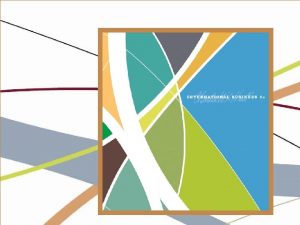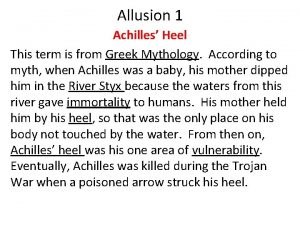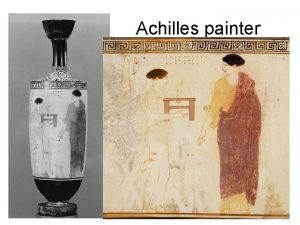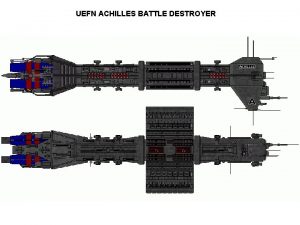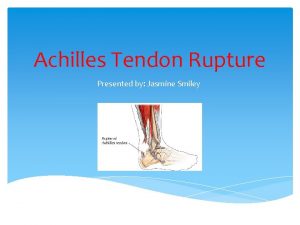Achilles Heel An Achilless heel is a term










- Slides: 10

Achille’s Heel

An Achilles's heel is a term for a person's weak spot and is based upon the hero who was dipped in the river that granted immortality; however, he was left vulnerable in the area he was held in: his heel.

Introduction • It is easy to forget how dependent we are on modern technology. • To appreciate it, we must witness its occational failure. • Summer 1996 failure of power. • Repeat of Great Northeast Blackout left for 13 hrs. ( 30 million people ) • The Electric animal

• 1996 blackout has highlighted the Underlying vulnerability of this formidable system. • When some thing goes wrong, it can cascade through the system. • Often ignored property of complex networks : : – Vulnerabilty due to interconnectivity

• • • Errors and failures corrupt all human designs. Eg: Car’s Engine But natural systems are Different Species disappeared at a rate of one per million each year. ( 3 mil – 100 mil species) No harm, Insensitivity to errors and failures, yucatan Meteorite-Dinosaurs. Eco-system displays tolerance, rarely seen in human made systems. Introduce Robustness-oak(strength and longevity) Achieving robustness is the ultimate goal in interdependent comm systems. Maintain a highdegree of readiness despite errs.

• Nature strives to acheive robustness through interconnectivity. • DARPA-Defense Advanced Research Projects Agency. Study Fault-tolerant N/ws • Node Failures can easily break a n/w into isolated non communicating fragments. • How long will it take to break when we start removing the nodes randomly? • How many routers must we remove from the internet to break it? • 80% node removal didnot affect the network connectivity. • The Unsuspected robustness against failures is that SFN’s display a property not shared by Random Networks • Their wellknown resilence to errors is an inherent property of their topology.

• What is the source of this amazing topological robustness? • Existence of hubs , (the few highly connected nodes). • Failures affect small nodes and large hubs with the same probability. • 10 red of 10000 white balls • Small nodes contribute little to networks integrity • Accidental removal of a single hub is not fatal, other hubs manage the integrity. • Failures disproportionately affect small nodes. • Do all the SFN’s display the same degree of tolerance? • For the SFN’s the critical threshold disappears in cases and the degree exponent is smaller or equal to three. • Therefore the networks break apart only after all nodes have been removed.

• The removal of a few hubs broke the internet into tiny, hopelessly isolated pieces. • Therefore, the response of SFN’s to attacks is similar to the behavior of random networks under failure. • Hidden with their structures, SFN’s harbor an unsuspected Achilles heel, coupling a robustness against failures with vulnerability to attack. • Otter-1911 , urchins and kelps example. • Although SFN’c are vulnerable to attack, several of the largest hubs must be simultaneiously removed to crash them. (5 -15%) • To disable the several hubs the crackers should disable the several hundred routers first and is very time consuming. • Despite its Achilles heel, the internet’s topology harbors strong defense against both random breakdowns and malicious assaults.

• Cascading Failures • Routers do not break down under too mush traffic. • They Queue, process and drop the rest. • 1996 blackout example. • Topological Robustness is a structural feature of networks. • Cascading Failures are a dynamic property of complex systems. • Ends with ’ there are still undiscovered laws that govern cascading failures.

Conclusion • The Topology, Robustness, and Vulnerability cannot be fully separated from one another. • All complex systems have their Achille’s Heel.



